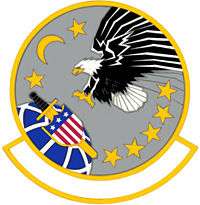39th Rescue Squadron
| 39th Rescue Squadron | |
|---|---|
|
39th Rescue Squadron Patch | |
| Active |
14 November 1952 – 24 November 1957 16 January 1967 – 30 April 1972 1 January 1992 – 1 August 1994 15 April 1997 - Present |
| Country | United States |
| Branch | United States Air Force |
| Type | Search and Rescue |
| Part of |
Air Force Reserve Command 10th Air Force 920th Rescue Wing 920th Operations Group |
| Garrison/HQ | Patrick Air Force Base |
| Nickname(s) | Crown/King |
| Decorations |
|
| Commanders | |
| Current commander | Lt Col Jeffery D. Hannold |
The 39th Rescue Squadron (39 RQS) is part of the 920th Rescue Wing at Patrick Air Force Base, Florida. It operates HC-130P Hercules "Combat King" aircraft conducting search and rescue (SAR) and combat search and rescue (CSAR) missions. An Air Force Reserve Command (AFRC) unit, it is operationally-gained by the Air Combat Command (ACC).
Mission
As an Air Force Reserve Command (AFRC) unit, the mission of the 39 RQS is to rapidly deploy HC-130P aircraft and personnel to austere airfields and denied territory in order to execute all-weather personnel recovery operations anytime...anywhere. 39 RQS flight crews routinely perform high and low altitude personnel & equipment airdrops, infiltration/exfiltration of personnel, helicopter air-to-air refueling, and forward area refueling point missions. When tasked, the 39 RQS also conducts humanitarian assistance operations, disaster response, security cooperation/aviation advisory, emergency aeromedical evacuation, casualty evacuation, noncombatant evacuation operations. During the Space Shuttle program, the 39 RQS also provided DoD manned space flight support for NASA.[1]
History
The 39th conducted search, rescue, and escort missions in Japan and Korea during and following the Korean War and in Southeast Asia from January 1967 to April 1972. It also flew missions included refueling rescue helicopters and performing airborne command, control, and communications functions during combat rescue operations. The 39th again flew search and rescue in and around Japan from 1992 until 1994. It has trained for combat search and rescue, performed search and rescue missions, and refueled rescue helicopters since 1997.[2]
Operations[2]
On 16 January 1967, the squadron was formed at Udorn Royal Thai Air Force Base with six Lockheed HC-130Hs transferred from the 37th Aerospace Rescue and Recovery Squadron.[3]
On 8 June 1967 the squadron relocated from Udorn RTAFB to Tuy Hoa Air Base, South Vietnam and began to receive HC-130Ps to replace their HC-130Hs.[4] The HC-130P was the first aircraft able to refuel helicopters and so provided a dramatic increase in range for helicopters, particularly those involved in CSAR missions.[5] By mid-1969, the squadron was operating 11 HC-130Ps from Tuy Hoa.[6]
On 16 September 1970 the squadron relocated from Tuy Hoa AB to Cam Ranh Air Base.[7]
In March 1972 the squadron moved from Cam Ranh AB to Korat Royal Thai Air Force Base. On 1 April 1972, the 39 ARRS was dissolved and the aircraft and crews temporarily became part of Detachment 4 of the 3rd Aerospace Rescue and Recovery Group at Korat. On 8 July 1972 the Detachment was redesignated the 56th Aerospace Rescue and Recovery Squadron (56 ARRS). The squadron was inactivated as a Regular Air Force unit in 1994 concurrent with inactivation of the 432d Fighter Wing.[8]
The 39th Rescue Squadron (39 RQS) was reactivated in 1997 as an Air Force Reserve Command unit within the then-920th Rescue Group (920 RQG), later redesignated as the 920th Rescue Wing (920 RQW), at Patrick Air Force Base, Florida, assuming operation of HC-130P aircraft and associated HC-130P aircrew personnel assets previously resident in the co-located 301st Rescue Squadron. Since that time, the squadron has provided rescue support to NASA on the Eastern Range during the Space Shuttle program, participated in domestic humanitarian operations following the landfall of Hurricane Katrina along the U.S. Gulf Coast, and following the attacks on the United States of 11 Sep 2001, has made repeated combat deployments in a mobilized active duty status to Iraq and Djibouti in support of Operations Iraqi Freedom (OIF) and Enduring Freedom (OEF).
Lineage[2]
- 39th Air Rescue Squadron (1952 – 1967)
- 39th Aerospace Rescue and Recovery Squadron (1967 – 1990)
- 39th Air Rescue Squadron (1990 – 1993)
- 39th Rescue Squadron (1993 – 1994; 1997–present)
Assignments[2]
- 3d Air Rescue Group (1952–1957)
- 2d Air Rescue Group (1957)
- 3d Aerospace Rescue and Recovery Group (1967–1972)
- Air Rescue Service (1992–1993)
- 432d Fighter Wing (1993–1994)
- 939th Rescue Wing / 920th Rescue Group (1997 – 2003)
- 920th Rescue Wing (2003–present)
Bases stationed[2]
- Ashiya Air Base, Japan (1952–1957)
- Udorn Royal Thai Air Force Base, Thailand (1967)
- Tuy Hoa Air Base, South Vietnam (1967–1970)
- Cam Ranh Air Base, South Vietnam (1970–1972)
- Korat Royal Thai Air Force Base (1972)
- Misawa Air Base, Japan (1992–1994)
- Patrick Air Force Base, Florida (1997 – present)
Aircraft Operated[2]
- SA-16 Albatross (1952–1957)
- SC-47 Skytrain (1952–1957)
- SH-19 Chickasaw (1952–1957)
- HH-60G Pave Hawk (1992–1994)
- HC-130H and HC-130P Hercules (1967–1972, 1997 – Present)
See also
References
![]() This article incorporates public domain material from the United States Air Force website http://www.af.mil.
This article incorporates public domain material from the United States Air Force website http://www.af.mil.
Notes
- ↑ http://www.af.mil/AboutUs/FactSheets/Display/tabid/224/Article/104509/hc-130pn-king.aspx
- 1 2 3 4 5 6 AFHRA 39 RQS Page
- ↑ Tilford, Earl (1980). Search and Rescue in Southeast Asia 1961-1975. Office of Air Force History. p. 76. ISBN 978-1-4102-2264-0.
- ↑ Tilford, p. 85
- ↑ Tilford, p. 84-85
- ↑ Tilford, p. 96
- ↑ Tilford, p. 113
- ↑ Tilford, p. 115

